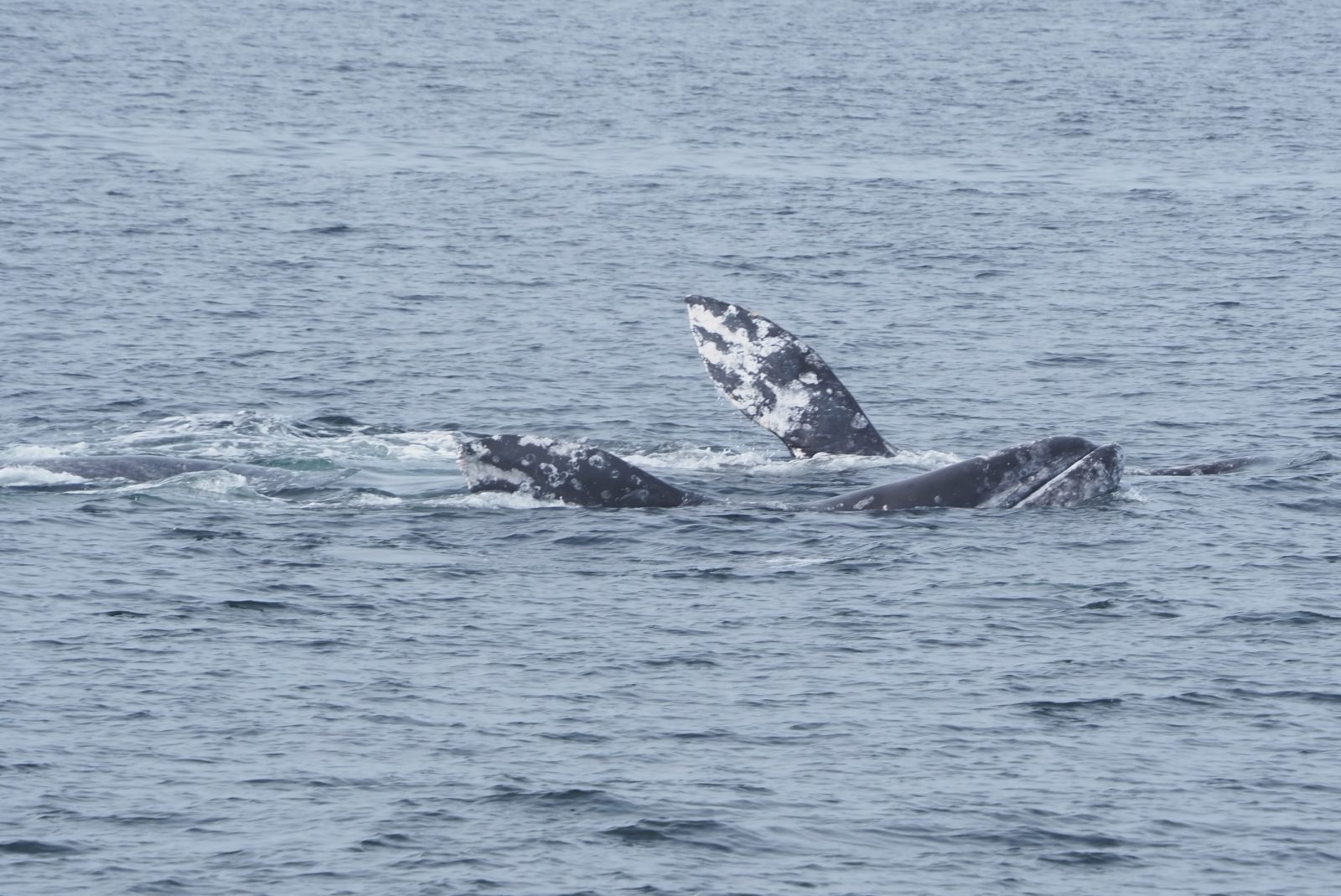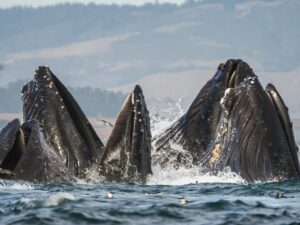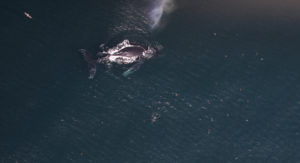April is the peak month for gray whales passing by the San Francisco Bay Area, drawing spectators to the coast to scan the ocean’s surface for a heart-shaped spout or the flick of a gray-speckled tail. But while the abundance of whales in the Bay Area this time of year increases your chances of seeing one, it also increases the chances of gray whales washing up dead on regional shorelines. The discovery of four dead gray whales in the Bay Area during the first week in April is a reminder both of the number of whales offshore and of a significant, still-unexplained die-off that’s affected gray whales on the West Coast since 2019.
The four whales were found between March 31-April 8 in various locations throughout the Bay Area: Muir Beach in Marin County, Fitzgerald Marine Reserve in San Mateo County, Crissy Field just inside the Golden Gate, and at the Berkeley Marina. According to The Marine Mammal Center, the deceased adult female found at Muir Beach had blunt force trauma consistent with a ship strike, and the adult female found at Fitzgerald Marine Reserve also appears to have died from a collision with a ship. Scientists with The Marine Mammal Center said they haven’t determined a cause of death for the other two gray whales.
When a dead whale is reported in the Bay Area, The Marine Mammal Center teams up with the California Academy of Sciences to examine the remains. “We have different specialties that both teams are good at, so that works really well on the actual necropsy,” says Moe Flannery, a senior collections manager with the Academy who is part of a NOAA-organized West Coast Marine Mammal Stranding Network. Flannery’s team focuses on the whale’s skeleton to find signs of injury, she says, while The Marine Mammal Center looks at the soft tissues for signs of disease, parasites, and other body conditions.
An abnormally high number of dead gray whales has kept both teams busy over the last few years. Scientists call the die-off an “unusual mortality event,” or UME, defined by the federal Marine Mammal Protection Act as an unexpected and significant die-off of a marine mammal species requiring an immediate response.
“The UME is basically an investigation started by NOAA [that] brings together scientists from, in this case, three different countries: Mexico, the U.S., and Canada,” Flannery says. Experts and field response teams have been working on the gray whale UME since 2019. “Once it shifts back to the pre-2019 average number of deaths per year, or once there’s a reason determined for the UME, then they will often be closed. But it’s still an open investigation, so it’s an ongoing event. This is just year three.”

Flannery says the recent spate of gray whale deaths in and around the Bay Area is unfortunate, but not that surprising given the ongoing die-off. “It was a lot of work, and it was a lot of animals in a very brief period of time, however, it’s not unexpected in the midst of an unusual mortality event,” she said. “The whales are migrating from Mexico to Alaska, and April is the peak time period they’re passing California, so having them wash up in the Bay Area in April is not a surprise.”
According to data from NOAA’s Southwest Fisheries Science Center, in 2016 the eastern North Pacific gray whale population was estimated to be at nearly its all-time high in the post-whaling era, with nearly 27,000 individuals. A report released by the agency in January stated that gray whales have declined by at least 23.7 percent since then, with an estimated population size of just over 20,500 whales in 2019-2020.
The UME is ongoing, although numbers from 2020 and 2021 seem to be less extreme than the spike in deaths during 2019. “2019 was the worst and then got a little better in 2020,” says Bill Keener, a research associate on The Marine Mammal Center’s Cetacean Field Research Team. However, Keener says that COVID restrictions meant that whale researchers had fewer opportunities to figure out what was happening last spring.
Experts have a few possible explanations for what’s causing this UME, which has been associated with an increase in seemingly emaciated or malnourished whales. The whales will typically be hungry on their journey northward, Keener says, “but there’s a difference between that and [being] emaciated where their ribs are sticking through, and they’re really starving.”
He says this could be because climate change is affecting the Arctic ecosystem where gray whales get their food. Warming ocean temperatures are reducing ice in the Arctic, which reduces the algae that gray whale prey—small invertebrates called amphipods—rely on. If gray whales can’t get enough amphipods, they may turn to other food sources that are insufficient for building up the blubber they need for their long migration.
“The only thing I would say optimistically, is that we’ve seen this before in 1999-2000. And the gray whales, their population did fully rebound,” Keener says. “But I think what’s different is that it’s three years, and we’re seeing gray whales inside the Bay for long periods of time, and that’s something we’ve never seen before.”

The gray line shows the trend line for the whale population estimates from 1994 to 2020, while the blue bars show the estimated number of gray whale calves born each year. (Courtesy NOAA)
During the 1999-2000 UME, the gray whale population dropped by 22.6 percent, similar to the first two years of the current UME. A definitive cause for the decline was never identified. “There are some hypotheses that this is a natural occurrence within the population, where it reaches a certain number of animals and then there’s a decrease in population size,” Flannery says. “Why that is, we’re not exactly sure. That’s why it’s an ongoing investigation still working to answer those questions.”
As marine mammal experts work to find answers, agencies, lawmakers, and conservation advocacy groups have been developing rules and policies to limit some of the threats that scientists know for sure are killing whales along the California coast: ship strikes and fishing gear entanglements. Most of these conservation measures — including NOAA’s seasonal voluntary Vessel Speed Reduction Requests and the California Department of Fish and Wildlife’s seasonal delays and new regulations on the crabbing industry — are intended to protect endangered blue, fin, and humpback whales, though gray whales could still benefit from the efforts. “Ships slowing down and changing fishing gear would help all whales that are along the West Coast,” Flannery says.
According to NOAA, there were 214 recorded gray whale strandings along the West Coast in 2019, 174 in 2020, and 42 so far this year as of April 5. In a 2009 report, NOAA scientists suggested that recorded strandings represent only 4-13 percent of all dead gray whales. “For every gray whale, particularly along our coast, that you might find stranded on a beach dead, there could be nine or ten out there in the ocean that you never saw,” Keener says.
Correction: This story has been changed to reflect that while gray whales may switch food sources in the absence of Arctic amphipods, there is no scientific literature to suggest they choose krill.





